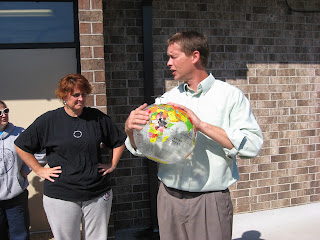Using the same concept in the post below the professor had solar powered fans that he purchased from Radio Shack (see second picture packaging). One was taped at the equator and one was taped at the north pole.
He took us outside and covered up the solar panels. He made a big deal of finding the most direct source of light from the sun and tilting the globe so that the equator was getting the most direct light. He released his hands from both locations and the fan at the equator was going full tilt but the one at the pole was going very slow (because it was getting less light).
This was a great demonstration of how certain parts of the earth receive more or less of the suns energy at different times of the year (causing our seasons).



Comments
I enjoy your blog and was inspired to do science notebooks in my science classrooms. My science team has a blog and would love to get feedback.
http://wiki.ccsd21.org/groups/d21_discoveryscience/blog/
You can also follow us on Twitter (@ScienceTeam21)
Thanks for all the wonderful ideas.
Sandy mills
Love your blog. I passed on the simple machines scavenger hunt to some of our 6th grade teachers.
Mrs. Whisnant -
Yes, that is Dr. Thompson. I'm really enjoying his class. He has lots of energy and good ideas.
Eve
Do you mind seeing if there's a place online that sells this product? Or if you could provide some more information the product that would be so helpful. I did go to Radio Shack online but didn't find anything.
Thank you for your help! What a great idea :)
~Mrs. G.
It is kind of expensive $23 but you would only need two for the demostration and it could be part of a grant write up.
Eve
http://www.amazon.com/gp/offer-listing/B005QDPUMY/?ie=UTF8&tag=homesolarpowergen-20&linkCode=ur2&camp=1789&creative=390957
I like the the Solar Made quote of $15. The shipping cost is quite high but if you contact the company directly they might wave the shipping cost.
Eve